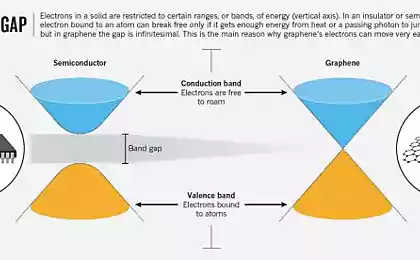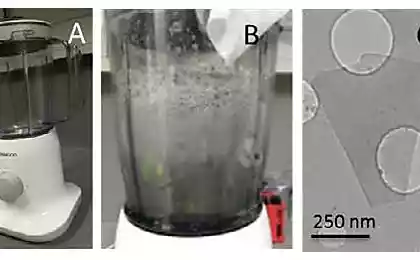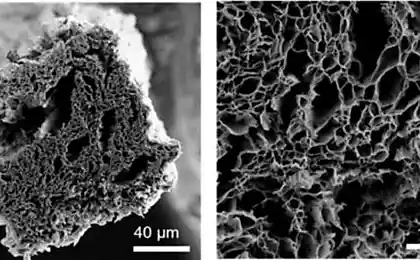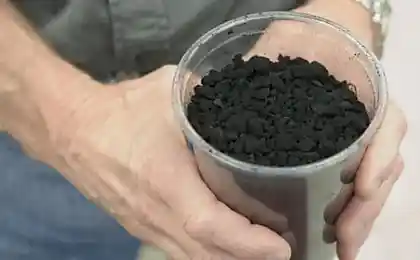533
Dutch scientists have created a colored "physical pixels" of graphene
Researchers from Delft technical University (Netherlands) made a discovery that may one day lead to new production technology displays. Scientists have created so-called graphene bubbles, which can change color upon expansion and in contact with each other. The researchers say that their "physical pixels" may one day become part of a new, more flexible, durable and energy efficient screens, compared with conventional LED.

However, experts point out that they created the technology is in its infancy. In itself, the production of graphene is very expensive, but there is also a new technology. In General, to rejoice the upcoming release of displays based on new technologies is premature.
Whatever it was, his discovery scientists made when working with plates of silicon oxide, which was covered with double layer graphene the thickness of two carbon atoms. Plates themselves contain tiny (thickness 10 times less than the thickness of a human hair) holes, which are closed grafenauer layer and create a sort of air bubble. Working with these samples, scientists have noted that the bubbles of graphene can change its color depending on the pressure which is available at the holes. When the pressure of the bubbles become either concave, or elongated and thus refract light passing through them, changing their color.

Technical drawing showing how the layers of graphene can be stretched over the cavities in the plates of silicon oxide
"In basic form, graphene is a transparent material. It is so thin that the light from it has almost no effect," says researcher Santiago Cartmel Bueno.
"However, we used a double layer graphene, so the light is refracted stronger."
When graphene bubbles gebalis and stretched, the light had to pass less or more than the distance from the substrate of silicon oxide. This, in turn, led to changes in how much of the light spectrum is absorbed and what is reflected back, which in turn was a change in color.
"Depending on the depth of the holes, you get a different level of interference. From this and the observed changes in the color," explains Cartmel Bueno.
The same principle is used for example in Mirasol technology from Qualcomm, where it is used of the reflective membrane, driven by electrostatics. As in the case of E-Ink displays, this technology shows a very high level of efficiency: once the screen displays the image in its support do not require the use of additional power. However, the feature of these displays is that the light in them cannot be used. It turns out that reading such displays in the dark would be virtually impossible, but in bright light they remain perfectly readable.
However, the mass use of technologies screens based on graphene are numerous difficulties. First, changes in the color of graphene bubbles were observed only under the microscope, as we recall, the production of such graphene samples, but larger will be very expensive. As a result of "pixels" turned out to be so small that for creation on their basis of even a very small image it would take hundreds of thousands of these pixels. To produce graphene bubbles are larger, too, will fail – there is a possibility of their unstable behavior (they can simply to burst). Second, researchers at Delft technical University have not yet figured out how on this basis we can create a clean color.
"We have seen different colors. As a rainbow. However, we still cannot create net colors: for example, pure red or pure blue," explains Cartmel Bueno.

Artistic representation of graphene pixels
The next step for scientists is to find efficient and accurate control of the changed pressure in each individual cavity. Cartmel Bueno that his team is considering electrostatics, that is, the principle that is used in the Mirasol screens. Progress is already there. As in the case of Mirasol displays, the new technology will be very effective in the sunlight, while graphene will make these screens are very durable, flexible and light. The University currently is working on the first prototypes. Who knows, perhaps the first instances we will be able to see at the next exhibition MWC, which will be held in March next year. published
Source: hi-news.ru/technology/gollandskie-uchenye-sozdali-cvetnye-fizicheskie-pikseli-iz-grafena.html

However, experts point out that they created the technology is in its infancy. In itself, the production of graphene is very expensive, but there is also a new technology. In General, to rejoice the upcoming release of displays based on new technologies is premature.
Whatever it was, his discovery scientists made when working with plates of silicon oxide, which was covered with double layer graphene the thickness of two carbon atoms. Plates themselves contain tiny (thickness 10 times less than the thickness of a human hair) holes, which are closed grafenauer layer and create a sort of air bubble. Working with these samples, scientists have noted that the bubbles of graphene can change its color depending on the pressure which is available at the holes. When the pressure of the bubbles become either concave, or elongated and thus refract light passing through them, changing their color.

Technical drawing showing how the layers of graphene can be stretched over the cavities in the plates of silicon oxide
"In basic form, graphene is a transparent material. It is so thin that the light from it has almost no effect," says researcher Santiago Cartmel Bueno.
"However, we used a double layer graphene, so the light is refracted stronger."
When graphene bubbles gebalis and stretched, the light had to pass less or more than the distance from the substrate of silicon oxide. This, in turn, led to changes in how much of the light spectrum is absorbed and what is reflected back, which in turn was a change in color.
"Depending on the depth of the holes, you get a different level of interference. From this and the observed changes in the color," explains Cartmel Bueno.
The same principle is used for example in Mirasol technology from Qualcomm, where it is used of the reflective membrane, driven by electrostatics. As in the case of E-Ink displays, this technology shows a very high level of efficiency: once the screen displays the image in its support do not require the use of additional power. However, the feature of these displays is that the light in them cannot be used. It turns out that reading such displays in the dark would be virtually impossible, but in bright light they remain perfectly readable.
However, the mass use of technologies screens based on graphene are numerous difficulties. First, changes in the color of graphene bubbles were observed only under the microscope, as we recall, the production of such graphene samples, but larger will be very expensive. As a result of "pixels" turned out to be so small that for creation on their basis of even a very small image it would take hundreds of thousands of these pixels. To produce graphene bubbles are larger, too, will fail – there is a possibility of their unstable behavior (they can simply to burst). Second, researchers at Delft technical University have not yet figured out how on this basis we can create a clean color.
"We have seen different colors. As a rainbow. However, we still cannot create net colors: for example, pure red or pure blue," explains Cartmel Bueno.

Artistic representation of graphene pixels
The next step for scientists is to find efficient and accurate control of the changed pressure in each individual cavity. Cartmel Bueno that his team is considering electrostatics, that is, the principle that is used in the Mirasol screens. Progress is already there. As in the case of Mirasol displays, the new technology will be very effective in the sunlight, while graphene will make these screens are very durable, flexible and light. The University currently is working on the first prototypes. Who knows, perhaps the first instances we will be able to see at the next exhibition MWC, which will be held in March next year. published
Source: hi-news.ru/technology/gollandskie-uchenye-sozdali-cvetnye-fizicheskie-pikseli-iz-grafena.html























